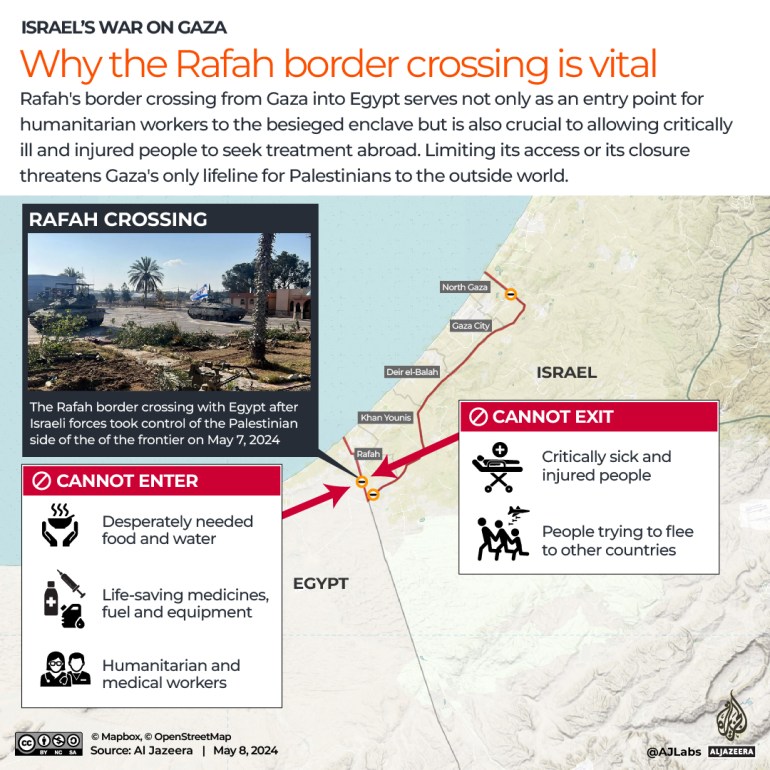A $320m floating pier built for delivering aid has been attached to Gaza’s shore and began being used to deliver aid on Friday, United States Central Command (CENTCOM) says.
Aid groups have criticised the pier as a costly and ineffective distraction from the fact that land deliveries are the most efficient way to help Gaza.
What was initially proposed as a way to supplement aid to a starving population as Israel’s punishing war on them continues may become the only source after Israel seized and closed the Rafah land crossing with Egypt. Israelis have also begun attacking aid trucks heading to Gaza through Israeli crossings.
CENTCOM said aid trucks are “expected to begin moving ashore in the coming days” via the pier. Shipping data shows the MV Sagamore cargo ship carrying the aid is near Cyprus after waiting in Ashdod, Israel, for a few days due to bad weather.
How does the pier work?
The US has long used Joint Logistics Over the Shore (JLOTS) to land troops and equipment in areas where they have no access to a fixed pier.
It is using the same capability to build the Trident Pier for Gaza.
The project has two components, a floating offshore barge that is a first point of arrival for aid deliveries and a 550-metre (1,800ft) causeway anchored to the shore.
Aid is assembled and inspected in Cyprus, in the presence of Israeli officials so it requires no further checks on arrival, then departs by cargo ship – the Sagamore, so far.
When it arrives after a journey of about 15 hours, aid is unloaded onto the floating pier and then loaded on trucks driven by aid workers that board smaller US Army boats to be transported to the Gaza shore.
When the operation reaches full capacity, 150 trucks are expected to make their way into Gaza daily.
International aid organisations say a minimum of 500 trucks are needed each day.
What are the main challenges?
The project stops on bad weather days as rough seas slow down the ships while the pier is unusable in waves higher than 90cm (three feet) or winds faster than 24km/hour (15mph), according to a 2006 US Naval War College paper on safe cargo handling.
Earlier this month, CENTCOM had to pause offshore assembly of the pier due to high winds and high sea swells, moving everything near Ashdod.
The project also needs complicated logistics and security with many moving parts and details yet to be finalised.
Every step added to aid delivery increases both cost and risk, Sarah Schiffling, deputy director of Finland’s HUMLOG Institute which researches humanitarian logistics and supply chain management, said.
“We’ve got this quite complex structure of what needs to happen – and then the aid still needs to be distributed in Gaza,” Schiffling said. “If you haven’t got fuel, then the whole thing doesn’t work.”
It is also unclear who will be responsible for each stage and who guarantees the safety of aid workers unloading and distributing aid. On Thursday, CENTCOM said: “The United Nations will receive the aid and coordinate its distribution into Gaza,” but did not specify whether this would be the arrangement throughout.
International and local organisations are painfully aware that past aid distributions in Gaza have ended in tragedy.
Israel’s military has attacked aid workers’ convoys and premises in Gaza at least eight times since October, with Human Rights Watch saying none of the aid organisations were warned before the attacks.
On Monday, a foreign United Nations staff member was killed in an attack in eastern Rafah when the vehicle they were travelling was shot at. Last month, Israel struck a convoy belonging to World Central Kitchen, killing seven aid workers.
Why is the project controversial?
The pier has been criticised as a complicated and costly alternative that tries to deflect attention from demanding a more appropriate and much simpler solution – for Israel to open land crossings to Gaza and to secure aid trucks going in.
Israel has been ordered to open more land crossings by the International Court of Justice as part of a case brought by South Africa accusing Israel of genocide in Gaza.
The court order in March was followed by a modest increase but aid remained nowhere near enough to meet the overwhelming need, according to UN and nongovernmental aid agencies.
Humanitarian aid had been trickling in through the Rafah crossing but came to a halt when the Israeli military seized control of the area in its offensive in the southern city.
According to Schiffling, Ashdod, just north of Gaza, would have been better for aid delivery, but there is no political willingness. “There is sea infrastructure, it’s just not available to get the humanitarian aid in to then get it across the land border into Gaza.”

US authorities say the pier is intended to supplement, not replace, aid deliveries over land and have called for the opening of land routes.
“We’re in a situation where anything going into Gaza is fantastic and we want more of that,” Schiffling said. “[Maritime aid delivery] can be an addition, but it cannot replace road access.”
US President Joe Biden said in his State of the Union address in March that the pier would “receive large shipments carrying food, water, medicine and temporary shelter”, a move largely seen as an attempt to appease his Democratic Party’s base as he runs for re-election in November.
The pier “looks quite spectacular and demonstrates what the US military can do without it being a military intervention”, Schiffling said.
“[W]e can understand why it was great for President Biden to announce it in his State of the Union address.”
Washington has provided billions of dollars in aid as well as weapons that Israel has used in Gaza since October 7.

